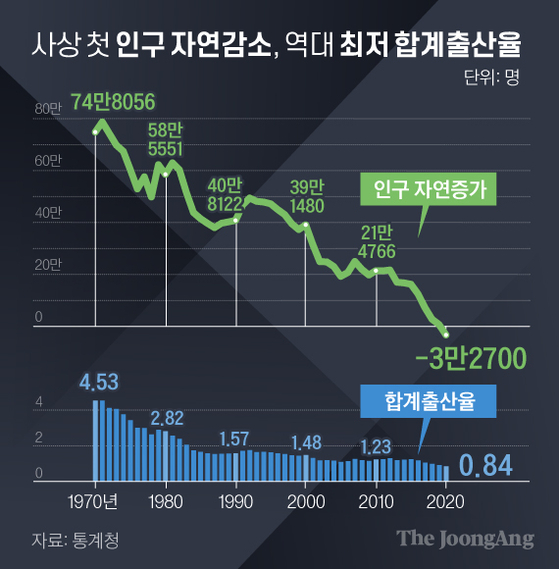Korea’s total fertility rate has fallen to 0.84, and the population has declined for the first time ever. Although the government has invested more than 200 trillion won over the past 10 years as a budget for responding to low birth rates, it did not work. It is the only country with a fertility rate of 0 among members of the Organization for Economic Cooperation and Development (OECD), and the gap with other countries is widening.

The first ever population decline. Graphic = Reporter Kim Kyung-jin [email protected]
According to the’preliminary results of 2020 birth and death statistics’ released by the National Statistical Office on the 24th, the number of births last year was 272,400, down 10% (3,300) from a year ago. Conversely, the death toll was 3,05100, an increase of 3.4% (10,000) from the previous year. As the number of children born and the number of people dying increased, the Korean population naturally decreased by 33,000 last year.
The population will decrease faster in the future.
Korea’s total fertility rate entered the 0 range for the first time in 2018 (0.98), and then continues to decline over 2019 (0.94) and 2020 (0.84). It is the overwhelming last among OECD member countries. The OECD average is 1.63 (as of 2018). Except for Korea, there is also a gap with Spain (1.26 people), which has the lowest total fertility rate.
Earlier, the National Statistical Office predicted that the total population of Koreans and foreigners living in Korea will peak at 5194 million in 2028 and gradually decrease from 2029 to 39.2 million by 2067. The Korean population has already begun to decline.
The number of deaths is also increasing. This means that the population may decrease more rapidly in the future. The crude mortality rate, which means the number of deaths per 1,000 people, was 5.9 last year, the highest in 33 years since 1987. “As the population is aging, the number of deaths continues to increase,” said Kim Soo-young, head of the Population Trend Division at the Statistics Office.
The possibility that the clock for natural decline in population will accelerate has also increased due to the novel coronavirus infection (Corona 19) that spread last year. In a recent report, the Bank of Korea predicted that next year’s total fertility rate could fall below the level of 0.72, the pessimistic scenario of the National Statistical Office, due to the delay in marriage and pregnancy due to Corona 19.

Population increase and decrease by province. Graphic = Reporter Kim Kyung-jin [email protected]
‘Population decline’ intensifies in the economic crisis
In the future, the crisis is expected to intensify in the fields of employment, education, medical care, and housing due to the declining population. The problem of compulsory expenditures such as the national pension is right in front of us. As the number of national pension subscribers decreases, the pressure to increase premiums is increasing, but discussions on pension reform have been sluggish since 2018. The problem of unfilled universities due to the decrease in the school-age population is also realizing.
The national debt continues to increase, but as the population decreases, the burden of individual debt increases. According to the long-term fiscal forecast of the Ministry of Strategy and Finance, the national debt per capita, which was 16 million won last year, is expected to exceed 114 million won by 2060.
Above all, one of the biggest problems with population decline is that it reduces overall economic growth. As the working-age population decreases, economic vitality decreases, and the welfare burden of aging increases like a snowball. It has no choice but to adversely affect economic growth, domestic demand and employment.
The BOK predicts that Korea’s potential growth rate will drop to 0.4% in 2026-2035. Tae-gi Kim, professor of economics at Dankook University, said, “The problem of low births is, in the end, closely related to the employment problem in society as a whole, including women, youth and the elderly. “We will be able to defend against the economic crisis caused by low birth rate and aging population.”
Average age of birth 33.1 years
Last year, the average birth age was 33.1, an increase of 0.1 years from the previous year. The first child was born at an average of 32.3 years, the second at 33.9 years, and the third at 35.3 years. In Korea, where most children are born to married couples, the age of childbirth is also increasing as young people tend to delay marriage. Fertility rates declined in all age groups except for the 40s. The early 40s (40-44 years old) also increased only 0.1%, and the late 40s (45-49 years old) remained unchanged (0%).
Of the couples who gave birth to children last year, 40.6% were married in the second to fourth years. 33.9% of couples had children within two years of marriage. Couples older than 5 years also accounted for 25.5%. By region, population grew naturally in six cities and provinces, including Gyeonggi-do, Sejong, Seoul, Ulsan, Incheon, and Jeju, with more births than deaths. In addition, the population of 11 cities and provinces naturally declined.
Sejong = Reporter Seongbin Lim [email protected]
![]()
